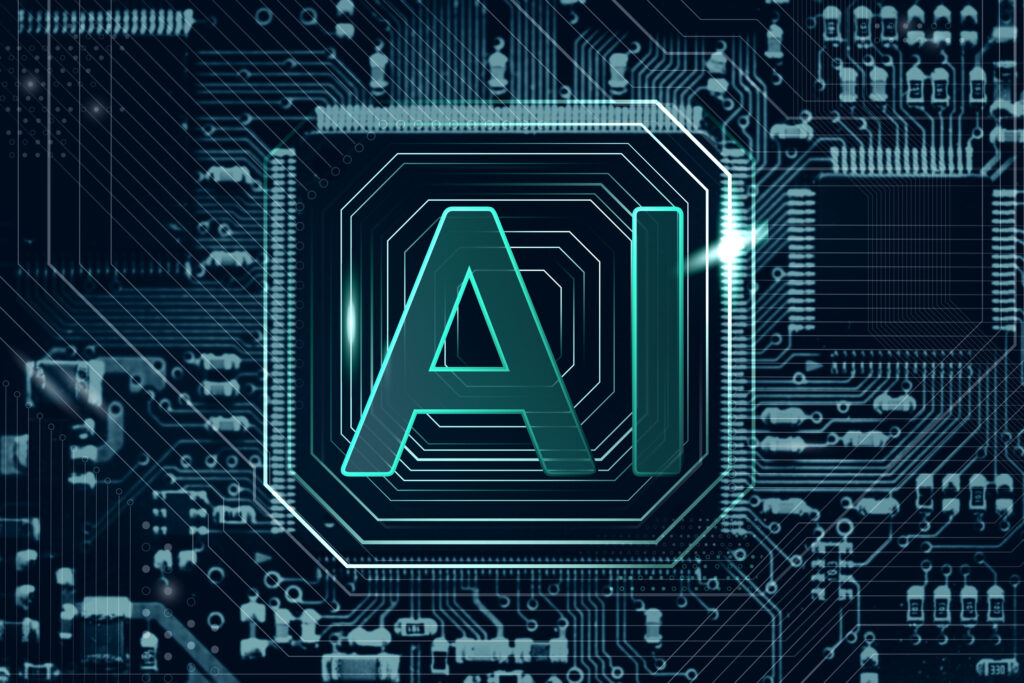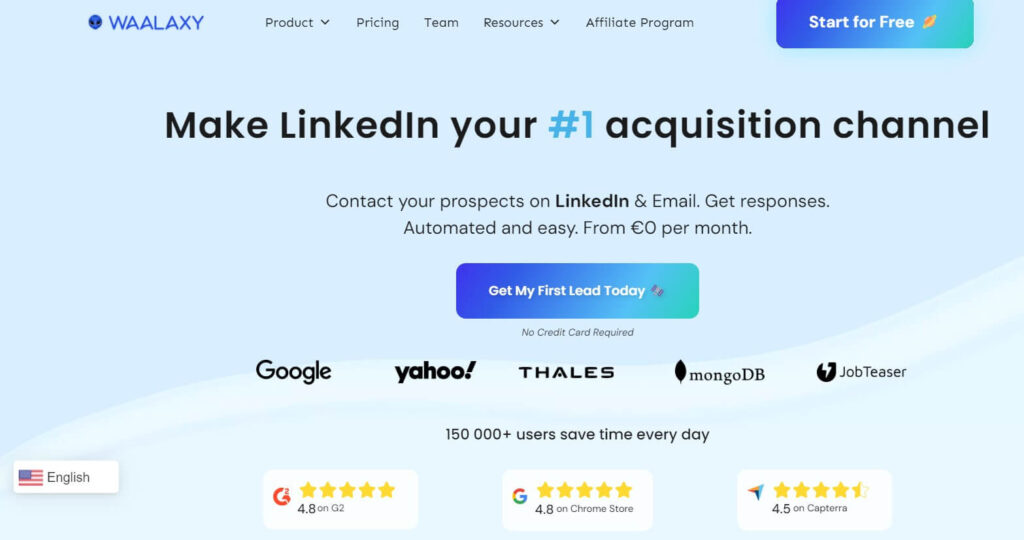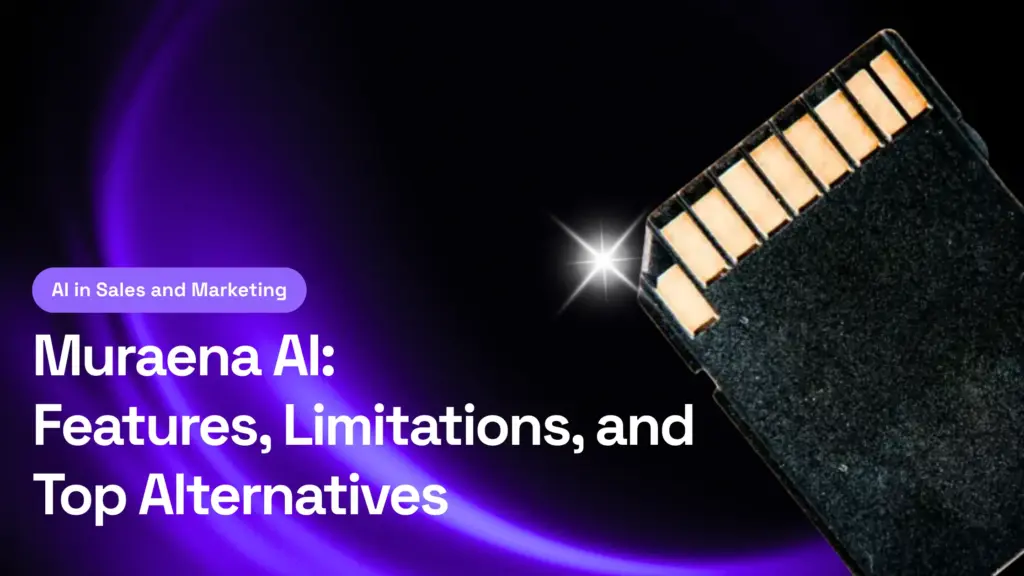Lead generation is the artery of business growth. The traditional lead generation process consists of prospecting and reaching out to potential customers. Businesses then nurture these cold leads to a point of conversion. Naturally, this is a tedious and often unequal process that costs much effort and time due to the vast scale of activities. Businesses often have to reach out to hundreds of prospects to generate a handful of warm leads — the exact clients who will make a purchase.
That’s where AI steps in: it makes lead generation more efficient, personalized, and scalable. With AI, businesses can find good leads faster, personalize their marketing messages, and get actionable insights.
This article considers how lead generation works with AI, its peculiarities, and targets best users. So, let’s get started!
What is Lead Generation with AI?
Lead generation is the process of identifying and attracting potential consumers for your organization. It begins with identifying prospects who may be interested in your products or services, and then nurtures these prospects through marketing activities until they become customers.
Integration of AI in Lead Generation Process
This approach can be complemented by artificial intelligence, which takes over routine processes, processes huge volumes of information, and structurally massages the results for communication with each client individually. At the same time, it accompanies all stages of the journey – from finding potential clients through their actions, to forming leads and maintaining contact with them. As a result, due to the application of artificial intelligence, each step becomes more detailed, while the speed is optimized, and the needs and desires remain as a priority – it is shown in the data.
Key Components of AI-Driven Lead Generation
- Data Collection and Analysis. Collects and analyzes data from numerous sources to detect patterns and fine-tune prospect targeting.
- Lead Scoring and Qualification. Predictive models are used to evaluate lead quality, prioritize high-potential prospects, and deliver personalized content based on their interests and actions.
- Automated Outreach. Personalizes outreach across many channels (e.g., email, social media), scheduling timely follow-ups, and automating interaction.
- Continuous Optimization. Continuously learns from ongoing efforts to improve future outreach initiatives by fine-tuning messaging, timing, and channel choice.
Main Differences When Using AI
The main differences when it comes to utilizing AI become visible. In the former case, a significant amount of time and effort went into conducting repetitive tasks. Sales teams spent hours flagging unsuitable prospects and completing the most suitable ones from an extensive target database. AI fully automates such activities and lets sales leaders to develop strategies and establish personal relationships rather than engage in them.
Moreover, AI can read and analyze vast amounts of data within minutes to identify the most qualified future repeat customers. All of this activity helps a company to generate leads faster and qualify more accurately. This is markedly heard through hyper-personalization, as AI tracks and quantifies user patterns and customizes the messaging to fit individual clients.
AI also scales much better than manual efforts because, unlike a sales representative, it can manage millions of possible transaction partners at the same time. All in all, AI has a drastic impact on efficiency and allows a company to work more effectively.
It quantifies leads and helps to choose the most important, pushy clients through predictive models. It sends follow-up communications automatically to thousands of clients based on their score to avoid overburdening your team. AI ensures quicker connections and some sales but cuts the energy burden related to making insensible calls. In the final analysis, companies accomplish more sales in less time.
Benefits of Using AI in Lead Generation
Improved Targeting and Segmentation
AI analyzes large amounts of data to detect trends and optimize prospect segmentation. Understanding client behavior, tastes, and demographics allows you to target specific groups more precisely. This guarantees that marketing efforts are directed toward prospects who are most likely to convert, avoiding wasted resources and increasing return on investment.
Enhanced Personalization
AI provides highly tailored interactions with potential customers by adapting information, message, and marketing to individual preferences and historical behavior. This level of customisation develops stronger relationships with prospects, making them feel appreciated and understood, hence increasing the possibility of conversion.
Predictive Analytics and Data-Driven Insights
AI uses predictive models to determine which prospects are most likely to engage or make a purchase. It assigns leads based on past data and current behavior, allowing sales teams to prioritize their efforts. AI’s data-driven insights also provide tips for refining strategy and messaging to improve campaign performance.
Increased Scalability and Automation
AI automates monotonous operations like email follow-ups and data input, freeing up your team’s time to focus on strategic initiatives. It also scales easily, allowing you to reach out to thousands of prospects at once while maintaining a personal touch. This enables organizations to scale their lead generating activities without increasing workload or sacrificing quality.
Who Should Use AI for Lead Generation?
AI-driven lead generation will work best in industries where customer acquisition falls into high-volume or highly-targeted categories. B2B, tech, marketing, and financial sectors will find AI a good fit in these sectors since it allows you to work their way through tons of data wrapped around promising leads. This is crucial for one thing: such sectors have decision-making staff or even specialized audiences which require a tactful AC approach.
Businesses of all sizes, from startups to established enterprises, may employ AI to generate leads. In the early stages of business, startups may need to identify customers and develop their initial customers. This can be accomplished swiftly with artificial intelligence without the necessity for a large sales staff. Mid-sized businesses may concentrate on lead nurturing and engagement, enabling sales growth and customer acquisition at the same time. Finally, big businesses may concentrate on harnessing artificial intelligence to get an in-depth grasp of their big client base and several channels.
Key Considerations for Implementing AI in Lead Generation
- Make sure your data is clean and organized, and that AI tools work easily with your current CRM or marketing platforms.
- Set specific goals, such as increasing conversions or shortening the sales cycle, so that AI solutions can align with these objectives.
- Educate your team about the possibilities of AI and how it will affect their roles, emphasizing how it will increase their efficiency rather than replace them.
- Regularly monitor the performance of AI-driven initiatives, using data insights to modify and adjust strategy.
Top 6 Best Practices for AI-Powered Lead Generation
1. Aligning AI Strategies with Business Objectives
Align your AI strategy with business objectives including lead gen goals. Do keep in mind that to get the most out of AI for lead generation, one must integrate their AI strategies into their leading objectives. In several words, you must consider what you desire to accomplish at the end when it comes to leads.
Would like to make improved leads to increase your conversion pace, or would like to shorten sales cycles second manner postulate to make revenue more quickly? Whatever the case might be, making your objectives distinct can help you establish an AI strategy to match them.
You can begin by arranging your objectives in order of preference and sheet them above precise measures associated with lead auto-generation. Should conversion rates be the concern, AI tools should be employed to examine when a shopper is likely to make a purchase keyword and whether an automatic message can be dispatched.
The following thing you must do is establish KPIs that define your accomplishments – by using the preceding illustration once more, if you aspire to decrease sales periods, your KPI measure might be the aggregate moment assigned in every funnel stage in the quantity of communications.
Once you’ve identified these, you should implement AI to support them immediately. This can indicate selecting tools that possess characteristics to aid the specific purpose aforementioned, configure your CRM to aid the data contributions required for AI analysis, or practice your staff to apply insights acquired through AI to their normal work.
This makes sure that AI solutions are employed deliberately, allowing your business to remain on objective while also offering results that may be evaluated. It not just speeds up the procedure of producing leads, but it also provides additional money for the buck.
2. Utilizing AI Throughout the Lead Generation Funnel
It is essential to leverage AI throughout the lead generation funnel to optimize the quality and efficiency of your approach. Use AI at the top of the funnel, during initial prospect identification, to apply predictive modeling to customer data and identify prospects with above-average potential based on their behavior, demographics, and expressed interest. You can direct more of your time and effort toward those who can truly convert.
AI can also assist at the qualification stage by enabling automatic assessment of leads against predefined criteria. This guarantees that only the best leads are followed up on by your sales team’s humans. For nurturing, you can leverage AI to contact leads automatically and personally. This ensures that relevant, timely content is delivered to the appropriate individual through the ideal medium and establishes credibility and trust, which leads to engagement.
Finally, AI-based scoring allows salespeople to follow up with leads based on their readiness to purchase. AI constantly refines its scores based on prospects’ reactions and provides real-time consolidations to salespeople to optimize their engagement.
In conclusion, AI can help identify, qualify, nurture, and convert leads through the funnel, allowing you to spend more time pursuing viable leads and closing deals with a higher success rate.
3. Continuously Optimizing AI Algorithms and Models
The effectiveness of AI algorithms and models thrives on continued improvement. To maintain your AI’s effectiveness, regularly monitor campaign results and review the insights your AI tools generate. This way, you will identify areas in which your strategies require adjustment. Therefore, you will be able to adapt your tactics to the prevailing market conditions and your customers’ ever-changing needs in real time.
Continuous improvement ensures that your lead generation efforts remain adaptable and flexible. It occurs through iterative review and progression of predictive models to refine scoring requirements, updating email content based on engagement patterns, and modifying prospect segmentation criteria to continue aligning with your ideal customer. Regular testing, learning, and iteration ensure that AI becomes better and more effective in ensuring higher lead quality and growing the number of conversions.
4. Integrating AI with Existing Marketing and Sales Systems
For businesses to make the most of AI, they must ensure that their AI tools are integrated seamlessly with the CRM, email marketing platform, and other existing sales and marketing systems. The integration creates an end-to-end workflow where all the relevant data can be transmitted to and from each system without creating any silos that would hinder effective decision-making.
For instance, when AI tools are synchronized with a CRM system, the sales and marketing team has access to a 360-degree view of each potential lead, from interaction history to recommendations. The seamless integration enables the teams to act first on the insights generated by AI. The action may include sending personalized outreach or following up on potential clients at times when they are likely to act on sales emails.
In addition, integrating AI helps in automating repetitive tasks such as data entry or section emails functions allow the sales team to focus more on productive roles like strategic planning and client follow-ups. Essentially, when AI tools integrated into the existing system, they not only save time but also improve the quality of data analysis in decision-making.
5. Investing in High-Quality Data
AI systems rely heavily on data, so its quality and organization play a crucial part in lead generation. By investing in high-quality data sources, you ensure the completeness and integrity of the information your AI models rely on while keeping your internal data clean, organized and up to date.
High-quality data sources also help your AI tools find relevant trends and patterns for more accurate predictive models driving your lead scoring and targeting processes. Use external sources to cross-reference your internal data and enrich your best customer profiles with intimate insights into their behavior and preferences.
Finally, organized internal data helps your AI models learn from accurate and relevant information without errors and biases — which makes AI model recommendations far more reliable. Audit and cleanse your internal datasets, remove duplicates and outdated information from sources. High-quality data overload will improve the overall performance of your AI systems, enabling you to launch more effective campaigns generating better results.
6. Experimentation and Testing
Continuously experiment to find the best AI strategies for your business. This entails running multiple A/B tests on your campaigns to determine what works best for your target market. A/B testing entails comparing campaign attributes and identifying the most successful alternatives.
Test different email subject lines, landing page formats, or even messaging templates to see what resonates best with your audience. Quantifying campaign success with metrics such as click-through rates and conversion rates will reveal the type of content, timing, and channel that elicits web users’ engagement.
In the same vein, conducting A/B testing on various audience groups will uncover which demographics are the most responsive to your business outreach. This will help you target only the most promising leads and make it easier for your AI models to prioritize them. Based on these findings, adjust your AI-driven strategy accordingly. Optimization increases campaign precision and, as a result, performance. You can get better results as a consequence of optimizing it.
Helpful AI Tools for Lead Generation
AnyBiz.io
AnyBiz is a comprehensive, AI-driven platform designed to revolutionize the B2B lead generation process. It stands out as a holistic solution that not only automates sales and marketing activities but also replaces the traditional role of Sales Development Representatives (SDRs) through its advanced AI sales agents. This innovative approach combines cutting-edge artificial intelligence and machine learning technologies to deliver an exceptional, personalized experience for businesses seeking to optimize their lead generation efforts.
Innovative Features and Differentiators
AI Sales Agents. At the core of AnyBiz is its AI-driven sales agent, which automates and enhances sales processes by crafting unique, multi-channel outreach sequences for each prospect. Unlike other tools, these virtual agents replace the SDR role entirely, making critical decisions such as the best timing, content, and communication channels to maximize engagement.
Continuous Operation. AnyBiz agents work tirelessly 24/7 without requiring days off, always aligning with prospects’ time zones to maintain continuous relationship-building. They can respond promptly to emails and other communications, allowing businesses to remain competitive and responsive.
Smart Decision-Making. The platform makes billions of decisions automatically, ensuring that every outreach action is strategic, purposeful, and designed to focus on closing deals. The agents learn and optimize their strategies continuously, analyzing over 10,000 data points per hour.
Personalization and Multi-Channel Engagement. With access to a vast database of over 80 million prospects, AnyBiz ensures every message is personalized, leveraging channels such as email, LinkedIn, and Twitter to prioritize building relationships. This creates a unique sequence tailored to the needs and preferences of each prospect.
Automated Email Classification and Response. The system classifies client emails into over seven categories and can respond automatically on behalf of the sales team, maintaining personalized engagement even during high-volume campaigns.
Dashboard and Metrics. The platform offers a dashboard to track metrics like brand awareness, opportunities created, market size, and time saved compared to hiring employees. It shows all activities performed by AI agents, including LinkedIn posts and emails sent to boost brand awareness.
Personalized Landing Pages. Every prospect receives a customized landing page featuring their name and company details, simplifying the process of booking calls or meetings. This landing page is crafted automatically, requiring no manual effort from the user.
Integrations and Calendar Management. The platform integrates seamlessly with existing CRM systems like HubSpot, providing a comprehensive view of engagement. It also includes a Calendly connector for easy meeting scheduling and supports communication status detection to continue conversations based on prospect replies.
Benefits and Opportunities
- Improved ROI. AnyBiz eliminates the need for SDR salaries or additional tools, offering significant cost savings while generating higher-quality leads.
- Enhanced Lead Quality. By automating the lead generation process with advanced AI algorithms, AnyBiz ensures the focus is on high-potential prospects, improving conversion rates.
- Brand Awareness. The system enhances brand awareness through multi-channel engagement and personalized landing pages.
- Business Growth Acceleration. Designed to scale businesses rapidly, AnyBiz’s AI sales agents automate lead generation activities to accelerate business growth.
In summary, AnyBiz provides a unique, comprehensive solution that disrupts traditional lead generation strategies with its AI sales agents, offering smarter, faster, and more reliable ways for businesses to connect with potential customers and close deals.
Waalaxy
Waalaxy, an automation tool for LinkedIn, is designed to streamline and automate outreach and follow-up activities. It boasts several standout features:
Multi-Channel Campaigns. Users can run campaigns through both email and LinkedIn, creating a unified communication strategy.
Importing Prospects. Users can directly import prospects from LinkedIn into the platform, providing structured management of leads.
Campaign Customization. Campaign settings are highly customizable, allowing users to adjust parameters to suit various outreach tactics and goals.
How AI Powers Automated Outreach and Follow-Ups
Automated Sequencing. AI sequences outreach and follow-up messages based on user interactions to achieve higher response rates.
Behavioral Triggers. AI uses behavioral data to trigger specific follow-up actions, ensuring timely and relevant prospect engagement.
SalesLoft
SalesLoft is a powerful sales engagement platform that helps sales teams enhance revenue by streamlining communication processes. It offers features like email tracking, automated dialing, and centralized sales data integration, making it easier to efficiently execute sales initiatives.
AI Integration with Data Analytics for Sales Engagement
- Sales Engagement. SalesLoft utilizes AI to optimize communication by automating personalized email sequences and suggesting the best follow-up times based on recipient behavior and engagement metrics.
- Data Analytics. The platform leverages AI to analyze performance data and sales interactions, providing valuable insights that help refine strategies, target the right clients, and improve overall sales results.
Want to know more? Read also – Best 15 LinkedIn Automation AI Tools for Lead Generation
Conclusion
To sum up, AI has made a tremendous impact on the lead generation with highly targeted strategies boosting overall engagement, communication smoothing, and generation of high-quality leads. When integrated into sales and marketing processes, AI automates many manual chores and frees up time for salespeople to develop deep customer relationships. As AI technology continues to evolve, it will continue to play an even more extensive role in lead generation, providing extraordinary precision and efficiency to the marketing and sales process.
The future will be bright for businesses seeking to capitalize on their opportunities at the speed of light, with ideal timelines producing excellent results and tweaking their outreach with incredible accuracy. As a result of the shift, businesses should begin incorporating AI with lead generation processes, helping them stay up to date on generating new leads and meet the developing market.
Related article:











